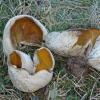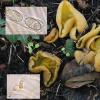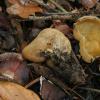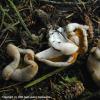
07-01-2026 10:24
 Danny Newman
Danny Newman
Pezicula sp. on indet. hardwood Appalachian Highl

07-01-2026 10:05
 Danny Newman
Danny Newman
cf. Chaetospermum on XylariaCosby Campground, Grea

02-01-2026 17:43
MARICEL PATINOHi there, although I couldn't see the fruitbody, I

04-01-2026 17:45
 Stephen Martin Mifsud
Stephen Martin Mifsud
I was happy to find these orange asmocyetes which

03-01-2026 13:08
Niek SchrierHi all,We found groups of perithecia on a Lecanora

29-12-2025 17:44
Isabelle CharissouBonjour,J'aimerais savoir si d'autres personnes au
Otidea / Sowerbyella
Miguel Ãngel Ribes,
29-05-2009 21:18
 Could you help me with this Otidea or Sowerbyella? It doesn't fit with anyone.
Could you help me with this Otidea or Sowerbyella? It doesn't fit with anyone.Thank you
François Valade,
29-05-2009 21:22

Re:Otidea / Sowerbyella
Miguel
Avec cette ornementation, il faut exclure le genre Otidea et rechercher vers Sowerbyella.
Je me demande si S. radiculata ne conviendrait pas
(http://www.ascofrance.fr/index.php?r=bdd&page=fiche&id=1497)
François
Avec cette ornementation, il faut exclure le genre Otidea et rechercher vers Sowerbyella.
Je me demande si S. radiculata ne conviendrait pas
(http://www.ascofrance.fr/index.php?r=bdd&page=fiche&id=1497)
François
Jean Pierre Dechaume,
29-05-2009 22:01
Miguel Ãngel Ribes,
29-05-2009 22:45

Re:Otidea / Sowerbyella
Thank you François, Jean Pierre
I had excluded S. radiculata by the habitat (not Juniperus / Cupressus) and the lack of stipe, but it is the first time I see it. Ok, S. radiculata.
Best regards
I had excluded S. radiculata by the habitat (not Juniperus / Cupressus) and the lack of stipe, but it is the first time I see it. Ok, S. radiculata.
Best regards
Miguel Ãngel Ribes,
30-05-2009 00:10

Re:Otidea / Sowerbyella
According to the papers that François has send me, I think it could be fits Ok with S. radiculata var. kewensis, which has smaller and ellipsoid ascospores compared with cylindric-ellipsoid ascospores measuring (13.5)-14-15.5-(16.5) x 7.5-9 microns in the typical variety of S. radiculata.
Thanks François,
Thanks François,
Nicolas VAN VOOREN,
30-05-2009 11:47

Re:Otidea / Sowerbyella
Je ne reconnais pas S. radiculata sur cette photo. MÊme si je ne l'ai pas vu souvent, ça me semble diffÃĐrent ; la photo de Jean-Pierre est plus significative.
Cette rÃĐcolte m'ÃĐvoque ÃĐgalement S. crassisculpturata. Ci-joint la photo de R. Chalange d'une rÃĐcolte que j'avais ÃĐtudiÃĐ et dont les cractÃĻres me semblent proches de ceux de Miguel.
Sur cette rÃĐcolte, spores de 14-16 x (6.5) 7.5-8 Âĩm.
Cette rÃĐcolte m'ÃĐvoque ÃĐgalement S. crassisculpturata. Ci-joint la photo de R. Chalange d'une rÃĐcolte que j'avais ÃĐtudiÃĐ et dont les cractÃĻres me semblent proches de ceux de Miguel.
Sur cette rÃĐcolte, spores de 14-16 x (6.5) 7.5-8 Âĩm.
Jean Pierre Dechaume,
30-05-2009 12:10
Miguel Ãngel Ribes,
30-05-2009 20:16

Re:Otidea / Sowerbyella
Ok, both species are very similar.
In Yao, Y-L. & B. Spooner. (2006), Species of Sowerbyella in the British Isles, with validation of Pseudombrophila sect. Nannfeldtiella (Pezizales). Fungal Diversiti, 22: 267-279, they said this about S. crassisculpturata:
"Sowerbyella crassisculpturata J. Moravec in Mycotaxon 23: 492 (1985).
= Sowerbyella radiculata (Sowerby: Fr.) Nannf. in Svensk Bot. Tidskr. 32: 119 (1938)
Examination of the Bristish specimen cited by Moravec revealed no significant character to distinguish it from other specimens of typical S. radiculata. S. crassisculpturata was separated from S. radiculata based on spore ornamentation which is 'a certain number of mature ascospores is sureticulate, but in the majority os ascospores is verrucose'.... They are very similar to those of typical S. radiculata. The characters emphasises by Moravec are considered here not to warrant recognition of S. crassisculpturata as a separate species from S. radiculata. They are, therefore, treated here as synonyms."
Anyway, boths species seem very closed, isn't it?
Thanks,
In Yao, Y-L. & B. Spooner. (2006), Species of Sowerbyella in the British Isles, with validation of Pseudombrophila sect. Nannfeldtiella (Pezizales). Fungal Diversiti, 22: 267-279, they said this about S. crassisculpturata:
"Sowerbyella crassisculpturata J. Moravec in Mycotaxon 23: 492 (1985).
= Sowerbyella radiculata (Sowerby: Fr.) Nannf. in Svensk Bot. Tidskr. 32: 119 (1938)
Examination of the Bristish specimen cited by Moravec revealed no significant character to distinguish it from other specimens of typical S. radiculata. S. crassisculpturata was separated from S. radiculata based on spore ornamentation which is 'a certain number of mature ascospores is sureticulate, but in the majority os ascospores is verrucose'.... They are very similar to those of typical S. radiculata. The characters emphasises by Moravec are considered here not to warrant recognition of S. crassisculpturata as a separate species from S. radiculata. They are, therefore, treated here as synonyms."
Anyway, boths species seem very closed, isn't it?
Thanks,




 7983.pdf
7983.pdf


